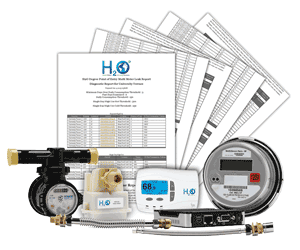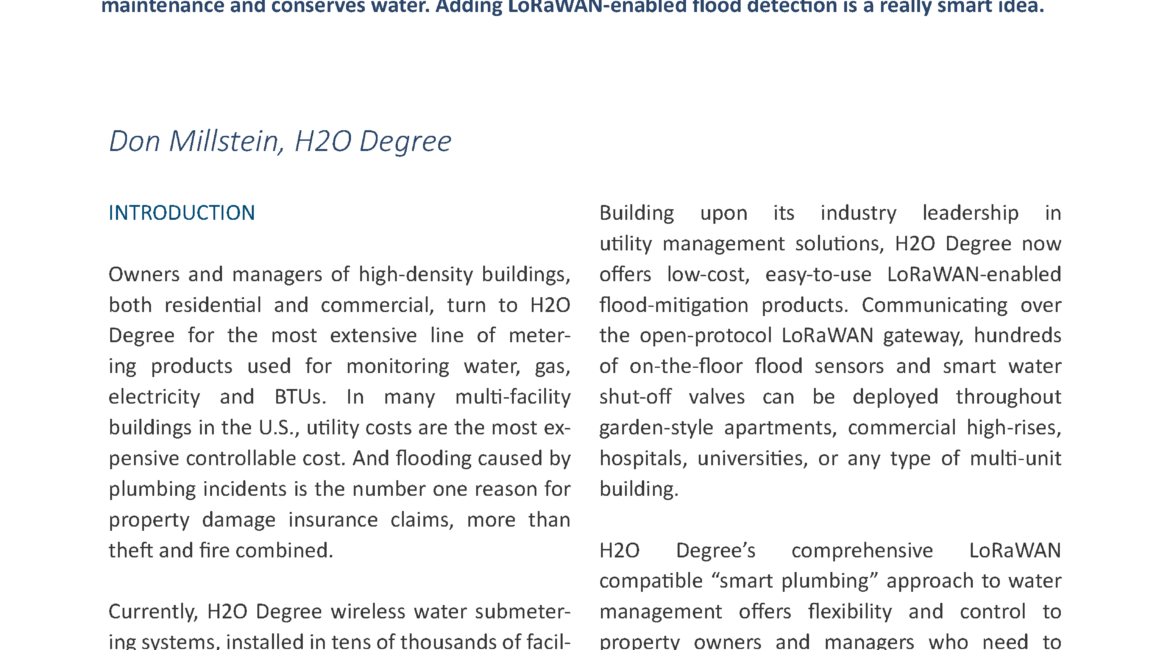
Smart Plumbing is a Smart Investment
Installing wireless water submetering systems in multi-family and commercial buildings facilitates maintenance and conserves water. Adding LoRaWAN-enabled flood detection is a really smart idea.
By Don Millstein, H2O Degree
INTRODUCTION
NEED FOR FLOOD PREVENTION
- Hot water heaters
- Sinks, toilets, bathtubs
- Washing machines
- Hose-fed appliances (e.g. water coolers, ice machines, dental/medical equipment)
- HVAC overflow pans
- Aging or frozen pipes and valves

 H2O Degree’s LoRaWAN Flood Detection Products
H2O Degree’s LoRaWAN Flood Detection Products
- LoRaWAN Compatibility
- Low Cost
- Easy set-up and programming
- Flexible, small footprint design
- Built-in radio
- Built-in battery backup


H2O Degree offers two types of on-the-floor flood sensors. First, is the LoRaWAN dual-probe water flood sensor LS4000, shown in Figure 1A. Two sensors can be plugged into the “box” part of the device to extend approximately three feet. When the pinpoint sensors detect water, the device wirelessly sends an alarm back to the LoRaWAN gateway indicating a leak. Ideal installations for this dual-probe water sensor include on the bathroom and kitchen floors and on the floor near hot water heaters and washing machines.
 H2O Degree’s other on-the-floor sensor is the LoRaWAN water flood rope sensor (LS5000). This device is designed to detect water along the full length of the 10-foot rope, which can be extended to monitor up to 3,000 mm of surface area (Figure 1B.) When water touches the rope, the sensor transmits an alert over the open protocol communications network. This rope sensor is perfect for large areas that might not be level and/or where water might pool on one side. It can be placed all the way around sinks, washing machines, etc. or can be put directly on a water pipe or riser pipe. The rope sensor can be installed across a variety of surfaces, including iron.
H2O Degree’s other on-the-floor sensor is the LoRaWAN water flood rope sensor (LS5000). This device is designed to detect water along the full length of the 10-foot rope, which can be extended to monitor up to 3,000 mm of surface area (Figure 1B.) When water touches the rope, the sensor transmits an alert over the open protocol communications network. This rope sensor is perfect for large areas that might not be level and/or where water might pool on one side. It can be placed all the way around sinks, washing machines, etc. or can be put directly on a water pipe or riser pipe. The rope sensor can be installed across a variety of surfaces, including iron.
Like the dual probe sensor, the rope sensor is quick and easy to set up and includes long battery life.
LS6000 LoRaWAN Smart Valve
The H2O Degree Smart Vale (LS6000) is designed with sensors hardwired to the valve and/or it can “talk” with multiple sensors installed throughout a building. For flexibility, it comes in a range of pipe sizes from 3/8″ up to 3″ (Figure 2A). The device is designed so that the valve can be detached from the box with the “smarts,” making it easy to place in tight locations (Figure 2B). Using exceptional deep indoor signal penetration, the H2O Degree LoRaWAN Smart Valve can continuously receive “water detected” information from sensors when it is plugged into a wall. If power is lost, the device can function for at least two months on its built-in battery.
Once water is detected by the on-the-floor flood sensors, a signal is sent over the LoRaWAN gateway. An open/close function in the LoRaWAN smart valve can be triggered remotely via a cell phone app (Android or IOS) to shut off the water, or it can close immediately. The smart valve can be attached on either point-of-entry or dual point-of-entry pipes on hot water heaters, washing machines, risers, irrigation and chillers.

Flood Detection Applications
The following are examples of flood-mitigation applications using H2O Degree’s flood mitigation system.


H2O Degree’s Smart Plumbing Approach 
H2O Degree offers a growing portfolio of LoRaWAN (long-range wide area network) products that integrate seamlessly with their existing systems. In addition to transceivers and gateways, these include LoRaWAN-enabled pulse counters, as well as sensors for humidity, open-windows, vibration and occupancy.
Unlike products that connect over proprietary protocols, LoRaWAN systems do not require a dedicated PC or software. One LoRaWAN gateway covers one 70-acre property or a 20-story building — and no repeaters are required.
H2O Degree’s LoRaWAN enabled water management systems facilitate; tenant billing (water usage), leak detection (wasted water) and flood detection (physical damage) in multi-family properties — or those with mixed-use occupancy like universities. Because sensors are relatively low cost, and eliminating repeaters saves on hardware, multi-unit buildings can add additional LoRaWAN enabled products as needs and opportunities arise.
The diagram in Figure 4 illustrates H2O Degree’s smart plumbing infrastructure. This installation includes LoRaWAN pulse-counters that combine with wireless water meters to monitor water flow and water wasting “events.” It also includes LoRaWAN on-the-floor water sensors and smart shut-off valves for flood mitigation. Using the open protocol network enables the sensors and other LoRaWAN devices to “talk” directly and then report back to the cloud where it can be accessed by the property manager, tenants, billing company or another user.

Customizing a Cadence Response
H2O Degree’s smart plumbing approach can be tailored to meet the requirements of the individual property owner or manager. The smart plumbing infrastructure enables users to respond to alerts in ways designed to optimize response.
When building managers get a “water detected” alert, or they want to follow up on a water leak report, they can customize a “cadence” — or reaction plan — according to their own circumstances and preference. All communication, including texts and emails, is centralized within H2O Degree’s dedicated web portal.
Take, for example, a multi-tenant building where the off-site property manager is alerted by text that water has been detected by an on-the-floor rope sensor in a bathroom. The cadence, or flow, of response will vary depending on the manager’s preference and/or the situation:
Option 1: Property manager uses his/her cell phone app to remotely shut off the water valve.
Option 2: Property manager accesses the LoRaWAN enabled occupancy sensor to detect movement in the apartment. If it is occupied, the property manager calls someone at the site to see if there is a harmless cause for the water alert, such as a tipped-over bucket.
Option 3: Property manager has set up the system to trigger a text alert. When there is no response after 15 minutes, the smart valve shuts off automatically.
Conclusion
H2O Degree’s wireless water submetering systems are already installed in apartments, condos, offices and other multi-tenant facilities, where they can quickly detect and resolve water leaks. Yet, as successful as these systems are in saving water — and money — the addition of LoRaWAN enabled flood detection and control makes plumbing even smarter. (In comparison, other solutions on the market offer either submetering systems OR flood mitigation products…not both.)
H2O Degree’s flood detection systems proactively prevent flooding by applying LoRaWAN on-the-floor water sensors and water shut-off valves. By augmenting their existing systems with low-cost, flexible sensors and smart valves, owners & managers can conserve water AND avoid debilitating costs due to flood damage all in one “smart plumbing” solution.
H2O Degree systems have been the chosen tool for energy management for 25+ years. To learn more about H2O Degree systems, contact our submetering experts at info@h2odegree.com. You may request a FREE site evaluation by visiting www.H2ODegree.com/sitesurvey
ABOUT H2O DEGREE
H2O Degree manufactures a broad line of wireless, radio-based submetering and leak detection systems that measure individual apartment or condo use of water, domestic hot water energy, boiler and chiller energy, electricity, gas and BTUs. The company also offers Green Thermostats, which track energy use and apartment temperature while allowing tenants and property owners to set temperature set-points and schedules, adjust set-back temperatures when tenants are away or asleep and report HVAC maintenance issues. For more information, please go to: www.h2odegree.com.

